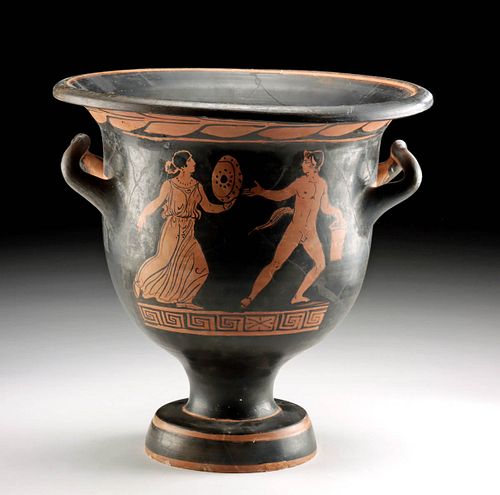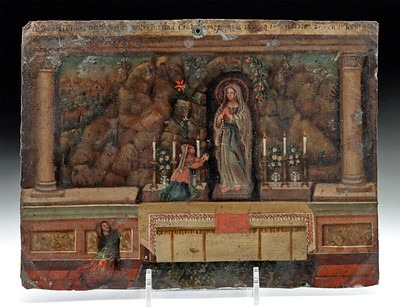Apulian Red-Figure Bell Krater, Satyr, Maenad & Ephebes
Lot 24
About Seller
Artemis Fine Arts
686 S Taylor Ave, Ste 106
Louisville, CO 80027
United States
Selling antiquities, ancient and ethnographic art online since 1993, Artemis Gallery specializes in Classical Antiquities (Egyptian, Greek, Roman, Near Eastern), Asian, Pre-Columbian, African / Tribal / Oceanographic art. Our extensive inventory includes pottery, stone, metal, wood, glass and textil...Read more
Categories
Estimate:
$5,000 - $7,500
Absentee vs Live bid
Two ways to bid:
- Leave a max absentee bid and the platform will bid on your behalf up to your maximum bid during the live auction.
- Bid live during the auction and your bids will be submitted real-time to the auctioneer.
Bid Increments
| Price | Bid Increment |
|---|---|
| $0 | $25 |
| $300 | $50 |
| $1,000 | $100 |
| $2,000 | $250 |
| $5,000 | $500 |
| $10,000 | $1,000 |
| $20,000 | $2,500 |
| $50,000 | $5,000 |
| $100,000 | $10,000 |
| $200,000 | $20,000 |
About Auction
By Artemis Fine Arts
Jun 15, 2023
Set Reminder
2023-06-15 10:00:00
2023-06-15 10:00:00
America/New_York
Bidsquare
Bidsquare : VARIETY Ancient, Ethno, Native American, Fine Art
https://www.bidsquare.com/auctions/artemis-gallery/variety-ancient-ethno-native-american-fine-art-12990
Antiquities, ethnographic, native american and fine art from cultures encompassing the globe. Artemis Fine Arts info@artemisfinearts.com
Antiquities, ethnographic, native american and fine art from cultures encompassing the globe. Artemis Fine Arts info@artemisfinearts.com
- Lot Description
Magna Graecia, South Italy, Apulian, ca. 325 to 300 BCE. A striking pottery bell krater featuring red-figure decoration of a satyr and maenad on one side and 2 robed ephebes on the other. Draped in a peplos, the maenad strides right, holding out a sizable tympanum to the nude satyr, who is depicted traditionally with the body of a man yet the tail and ears of a horse. The mythical male strides right while looking back at his partner and holding out a bucket in his left hand. Alternatively, the other side of the vessel features a pair of male youths wearing himations as they partake in discussion. Both scenes are adorned above by a laurel leaf motif above them that wraps around the rim of the vessel and a row of stopped meander designs below. The krater's exciting imagery is accompanied by an elegant silhouette with a classically bell-shaped body flanked by upward-swooping handles and supported by an elevated foot. Size: 10.5" Diameter x 10.3" H (26.7 cm x 26.2 cm)
Handsome bell kraters like this example were made to be used at a symposium or by someone aspiring to host one. Interestingly, in ancient Greek society, people mixed their wine with water, because drinking undiluted wine was frowned upon as it was thought to be the practice of a drunkard. Note how the imagery reflects the purpose of the vessel. The maenad and satyr are both followers of Dionysus (Roman Bacchus), the Greek god of wine, and were especially known for stories of drunken debauchery. Conversely, the robed ephebes in discussion represent the other side of a symposium: conversation, usually involving philosophical subjects such as love and the differences between the sexes (another topic which is then highlighted by the maenad and satyr).
Perhaps the most exciting innovation in Greek vase painting was the red-figure technique, invented in Athens around 525 BCE and beloved by other artists of Magna Graecia. The red-figure technique allowed for much greater flexibility as opposed to the black-figure technique, for now the artist could use a soft, pliable brush rather than a rigid metal graver to delineate interior details, play with the thickness of the lines, as well as build up or dilute glazes to create chromatic effects. The painter would create figures by outlining them in the natural red of the vase, and then enrich these figural forms with black lines to suggest volume, at times perspectival depth, and movement, bringing those silhouettes and their environs to life. Beyond this, fugitive pigments made it possible for the artist to create additional layers of interest and detail as we see in this example.
Provenance: private Rancho Mirage, California, USA collection, by inheritance in 2020; ex-Dr. TDR Berreth, California, USA, acquired before 1982
All items legal to buy/sell under U.S. Statute covering cultural patrimony Code 2600, CHAPTER 14, and are guaranteed to be as described or your money back.
A Certificate of Authenticity will accompany all winning bids.
We ship worldwide and handle all shipping in-house for your convenience.
#179011Professionally repaired and restored with overpainting on some break lines and other break lines visible. Some small nicks and abrasions commensurate with age. Otherwise, the vessel has a very nice presentation with good remaining pigments and detail.Condition
- Shipping Info
-
All shipping is handled in-house for your convenience. Your invoice from Artemis Gallery will include shipping calculation instructions. If in doubt, please inquire BEFORE bidding for estimated shipping costs for individual items.
-
- Buyer's Premium



 EUR
EUR CAD
CAD AUD
AUD GBP
GBP MXN
MXN HKD
HKD CNY
CNY MYR
MYR SEK
SEK SGD
SGD CHF
CHF THB
THB















